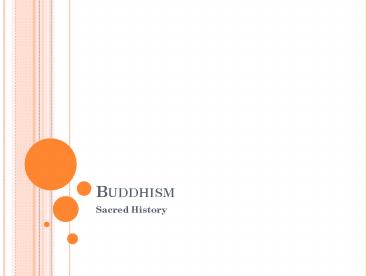Buddhism - PowerPoint PPT Presentation
1 / 17
Title: Buddhism
1
Buddhism
- Sacred History
2
Basic Terms
- Buddha one who is enlightened who has seen the
truth of dharma - Dharma the teaching of Buddha Buddha revealed
the teaching, dharma (his insight into the
nature of the world) which must be known to
follow the way of salvation - N.b. cf. Hinduism in which dharma was the law
which governed the cosmos - Nirvana final liberation the end of bondage to
the cycle of samsara
3
Emergence of Buddhism
- Foundations of Buddhism
- Founded by Siddhartha Gautama (the Buddha)
probably in 6th cent. B.C.E. - India
- Parallels some developments in Hinduism
- Roughly contemporary with Upanishads which had
introduced ideas of samsara, karma, etc. - W/ this developments in Hinduism came pursuit of
liberation through asceticism and/or mediation - Buddhism rejects tradition of Brahmans including
- Claims for the Vedas
- Caste system
4
Emergence of Buddhism
- Buddhism emerged during a time of intense
religious activity - Challenges to Brahmanical tradition
- W/ religious rituals and sacrifice
- Upanishads
- Asceticism
- Philosophy
- Knowledge of relationship between atman and
Brahman - Skepticism
- Materialism
- Jainism
5
Major Periods of Development
- Major Periods of Development
- The Early Period (6th cent. B.C.E.-1st cent. C.E.
- Time of Gautama Buddha
- Teaching consolidated and canon scriptures put
down in writing - Theravada Buddhism
- Mahayana Buddhism emerges c. 3rd cent. B.C.E.
- Classical Period (1st cent. C.E. onward)
- Spreads to China, Japan and Korea
- Medieval Period (7th 18th cent. C.E.)
- Importance of recitation of mantras
- Magical rites
- Modern Period
6
Expansion of Buddhism
- Unlike Hinduism, expansionary
- Adaptation to different cultural environments
- Early Buddhism non-theistic
- Theravada
- Southeast Asia (from 3rd cent. BCE)
- Sri Lanka (3rd cent. B.C.E.)
- Burma (now Myanmar) (3rd cent. B.C.E.)
- Combined with indigenous shamanistic practices
- Thailand (4th cent. C.E.)
- Cambodia (4th cent. C.E.)
- Indonesia (over 1000 inhabited islands) (4th and
5th cents. C.E.) - Hinduism (by 5th cent.)and Buddhist
- Now Muslim (but cf. Bali)
- By 13th cent. Sharp decline in India
7
Expansion (cont.)
- Mahayana
- Central and East Asia
- China
- Along with Confucianism and Taoism/Daoism
- Pure Land
- Chan
- Vietnam
- Chan esp. monastic
- Pure Land - villages
- Korea (4th cent. C.E.)
- Pure Land
- Son (Chan) esp. monastic
- Along with shamanistic practices
- Japan (6th cent. C.E.)
- Pure Land
- Zen (cf. Chan)
8
Expansion (cont.)
- Vajrayana and Tibetan Buddhism
- 7th cent. C.E.
- Indigenous religion - Shamanism
- Tantric Buddhism vs. Chan Buddhism
- Lamaism
- Lamas are spiritual leaders w/greatest authority
- Emergence of the Geluk-pa
- Brings together different schools of thought in
Tibetan Buddhism - Dalai Lama head of school of Geluk-pa
- Series of incarnations
- Incarnation of bodhisattva Avalokiteshvara
- Modern Buddhism
- Threatened by communism and secularism
9
Gautama Buddha
- Gautama Buddha
- Birth stories exhibit different attributes of the
Buddha in his past lives which he was perfecting - Largely legendary accounts point of stories is
to serve as paradigms for those who wish to
follow the same path - He is not a divine figure but he is a given a
status higher than ordinary people
10
Gautama Buddha
- Gautama
- Hindu of warrior class
- Prince- led a sheltered, protected life
- Birth
- Miraculous
- Bodhisattva takes form of elephant and Maya loses
desire to have sex - Marries at 16 and has child
- By having son, he is firmly bound to the
householder stage of life - Being groomed to be a chieftain
11
Mayadevi
12
Guatama the Four Sights
- Guatama is jolted by four sights
- An old man (old age)
- A sick person
- A corpse
- A wandering beggar one who has renounced the
world
13
Gautama The Great Renunciation
- The Great Renunciation
- At 29 takes on life of wandering recluse
- His desertion of princely life is a rejection of
things that are impermanent. - Sons name Rahula means fetter
- Takes on life of severe austerity and reflection
going through series of teachers - But eventually takes food represents rejection
of extreme asceticism - Attains enlightenment und the bodhi tree in which
he - Understands the nature of the world
- And the means to overcome suffering
14
Gautama The 3 Watches of Night
- Three Watches of the Night Under the Bodhi Tree
(around 35 years old) - White First phase of enlightenment in which he
sees all his own past lives/trajectories - Black Second phase he sees the preceding lives
of all creatures - Red Third phase he realizes the causal factors
which brings about these trajectories - Upon understanding the cause, he attains radical
enlightenment - Tempted to achieve nirvana but stays
- Buddha Undisturbed by Mara
15
Gautama The First Sermon
- Delivers first sermon Sermon of the Turning of
the Wheel which spells out his insight - Lays out idea of the middle path
- Expounds on the Four Noble Truths
- Expounds on the Eightfold Path
- He/she has broken bondage of samsara
16
Steering the Middle Path
17
Gautama Founds the Sangha
- Founds the sangha community dedicated to
following the path which lead to enlightenment - Following path requires withdrawal from society
and joining a monastic community - Men and women may achieve enlightenment
- Rejection of caste system
- Different levels of attainment may be achieved
- Final stage is that of arhant one who has
achieved nirvana and lives as one who is
completely enlightened - In Theraveda from of Buddhism, only monks nuns
may achieve enlightenment - Lay people may accumulate merit and reach a place
in future life where nirvana may become possible































